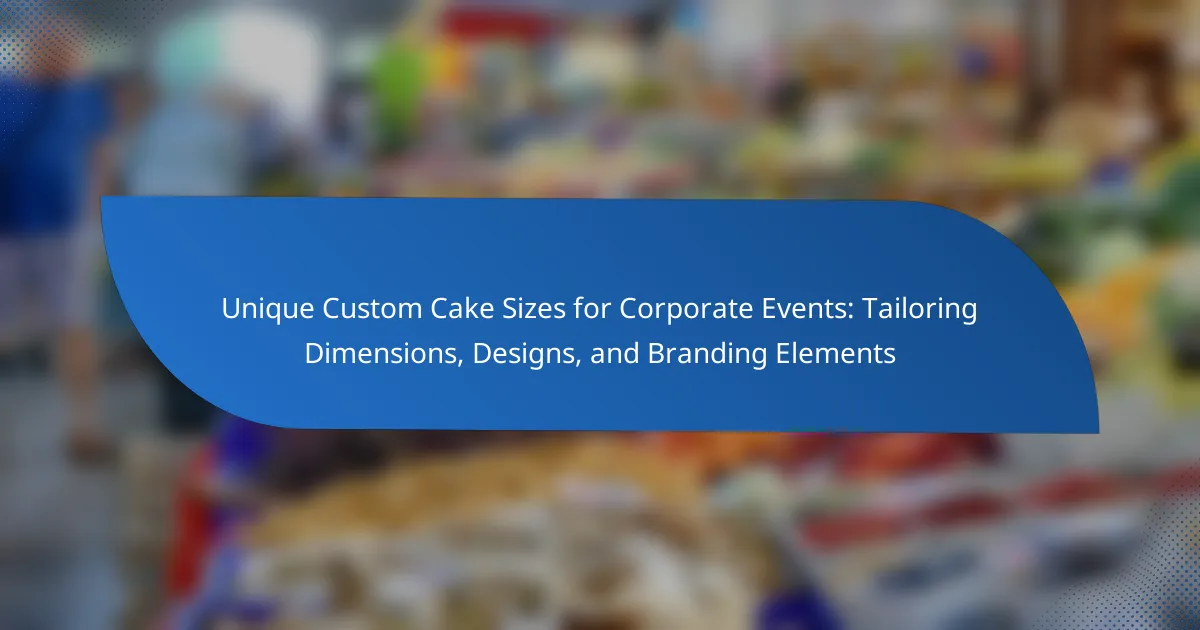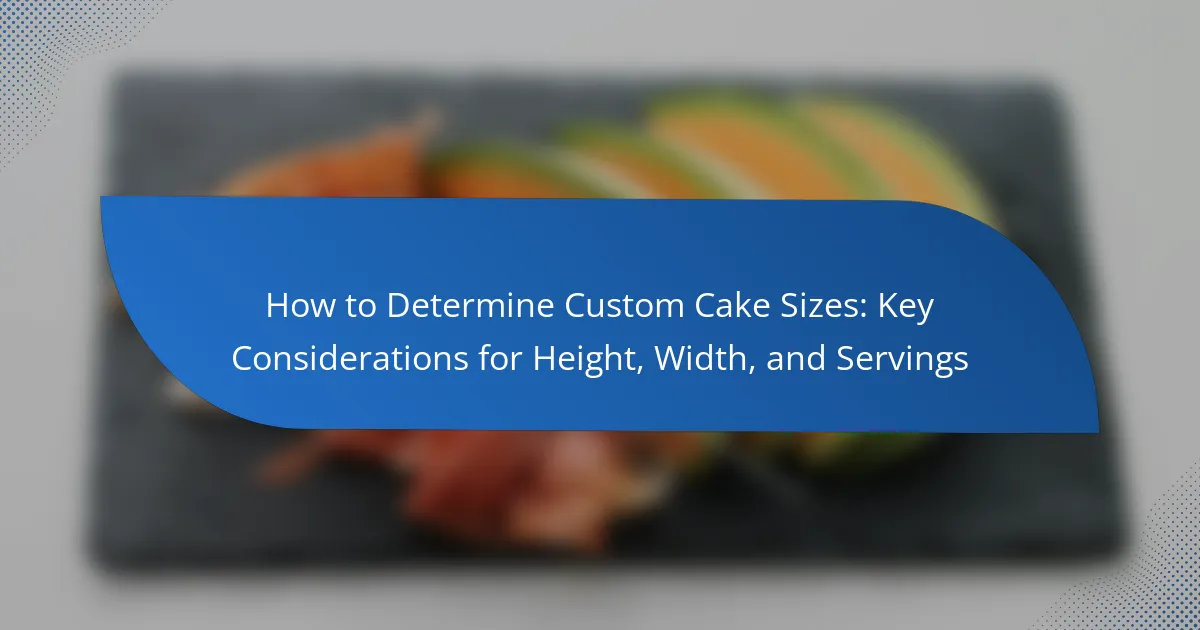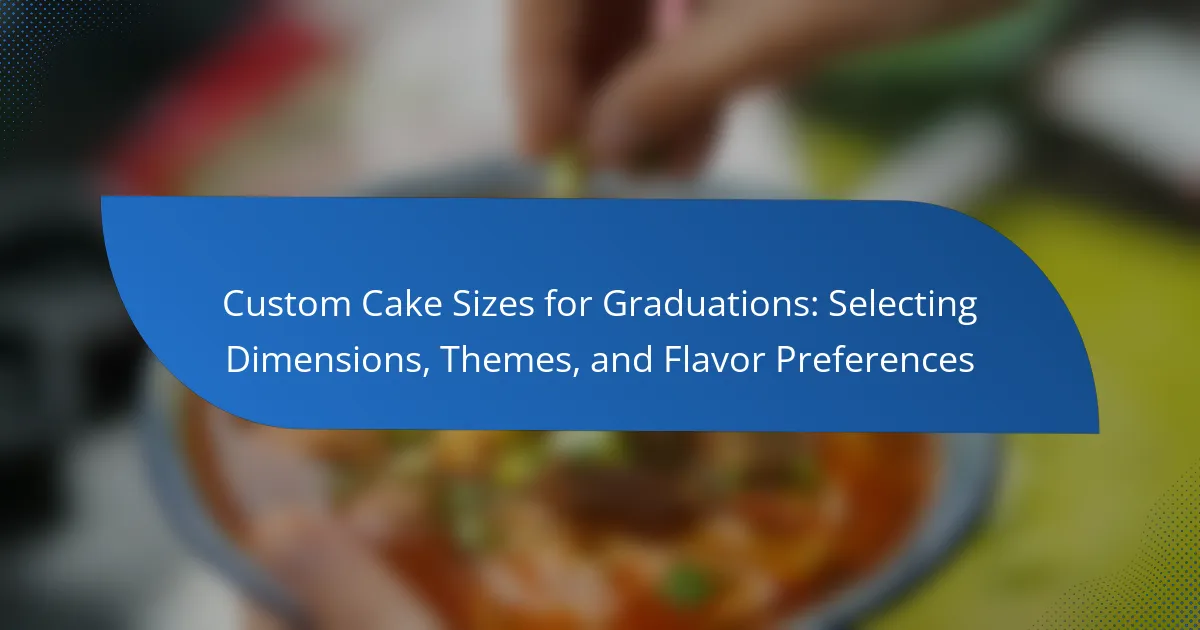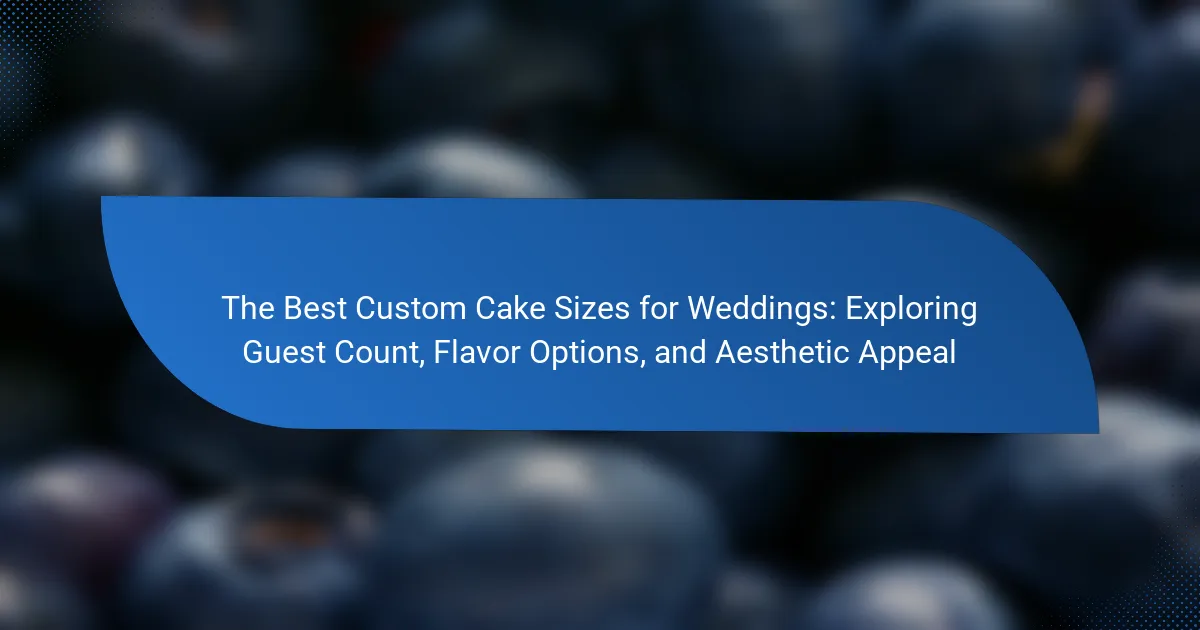Custom cake sizes play a crucial role in the presentation of cakes for various events. This article explores how different dimensions influence visual impact, allowing for tailored designs that align with specific themes. Larger cakes can create dramatic effects, while smaller cakes provide elegance and intimacy. The flexibility of custom sizes also facilitates unique shapes, enhancing aesthetic appeal and supporting creative decoration. Ultimately, selecting the right cake size contributes to a cohesive presentation that complements the overall decor of the occasion.

What is the impact of custom cake sizes on presentation?
Custom cake sizes significantly influence presentation. They allow for tailored designs that fit specific themes. A larger cake can create a more dramatic visual impact. Smaller cakes can offer elegance and intimacy. Custom sizes enable unique shapes that enhance aesthetic appeal. This flexibility supports creativity in decoration. The right size can complement the overall event decor. Ultimately, custom sizes contribute to a cohesive presentation that aligns with the occasion’s atmosphere.
How do dimensions influence the overall appearance of a cake?
Dimensions significantly influence the overall appearance of a cake. The height, width, and shape of a cake determine its visual impact. Taller cakes often convey elegance, while wider cakes can appear more substantial and inviting. Specific dimensions can enhance or detract from design elements such as frosting, decorations, and tiers. For example, a multi-tiered cake with varying heights creates visual interest. Conversely, a flat cake may emphasize simplicity. Additionally, the proportion of dimensions affects how decorations are perceived. Larger cakes allow for more intricate designs, while smaller cakes may limit detail. Overall, dimensions play a crucial role in the aesthetic appeal of a cake.
What are the common dimensions used for custom cakes?
Common dimensions for custom cakes typically include 6-inch, 8-inch, and 10-inch round cakes. These sizes are standard for tiered cakes and serve various occasions. Square cakes often come in similar dimensions, such as 6×6, 8×8, and 10×10 inches. Custom cakes can also be made in larger sizes, like 12-inch or 14-inch rounds for bigger gatherings. The height of custom cakes usually ranges from 4 to 6 inches per tier. These dimensions allow for intricate designs and themes to be effectively showcased. Such standard sizes are widely used in the baking industry for ease of serving and presentation.
How do different sizes affect the visual balance of cake designs?
Different sizes affect the visual balance of cake designs significantly. Larger cakes can dominate a design, creating a focal point. Smaller cakes can provide contrast and allow for more intricate detailing. The relationship between sizes impacts the overall composition. For instance, a tiered cake with varying sizes can create harmony and depth. Visual balance is achieved when the sizes complement each other. Studies in design principles show that proportionate sizes enhance aesthetic appeal. A well-balanced cake design draws the eye and maintains viewer interest.
What role do designs play in cake presentation?
Designs play a crucial role in cake presentation. They enhance visual appeal and create a thematic connection. A well-designed cake can evoke emotions and set the tone for an event. For example, intricate designs can signify elegance at weddings. Bold colors and unique shapes can attract attention at birthday parties. Studies show that visually appealing cakes are more likely to be chosen by consumers. According to a survey by the American Bakers Association, 72% of customers prioritize appearance when selecting cakes. Therefore, effective designs significantly impact consumer choices and overall satisfaction.
How can cake size affect the choice of design elements?
Cake size directly influences the choice of design elements. Larger cakes allow for more elaborate decorations and intricate designs. They can accommodate multiple tiers, which enhances visual appeal. Smaller cakes often require simpler designs due to limited surface area. The proportion of design elements must match the cake size for balance. For example, larger cakes can feature bold colors and extensive details. In contrast, smaller cakes benefit from minimalistic designs to avoid overwhelming the space. The choice of cake size also dictates the type of cake stands and serving options. Overall, the size of the cake is a crucial factor in determining design complexity and style.
What are some popular design trends for custom cakes of varying sizes?
Popular design trends for custom cakes include geometric shapes, watercolor effects, and floral arrangements. Geometric shapes provide a modern aesthetic, often seen in tiered cakes. Watercolor effects create a soft, artistic appearance, suitable for various sizes. Floral arrangements, both edible and non-edible, add elegance and can be adapted to any cake size. Additionally, metallic accents are gaining popularity, offering a touch of luxury. Minimalist designs focus on simplicity, often featuring clean lines and subtle colors. These trends cater to diverse tastes and occasions, enhancing the visual appeal of custom cakes.
Why are themes important in cake presentation?
Themes are important in cake presentation because they create a cohesive visual narrative. A well-defined theme enhances the overall aesthetic appeal. It allows the cake to resonate with the occasion, such as weddings or birthdays. This connection boosts emotional engagement for guests. Themes also guide design choices, including color schemes and decorative elements. Consistency in theme can elevate the perceived quality of the cake. Studies show that visually appealing cakes can increase customer satisfaction and sales. Thus, themes play a crucial role in effective cake presentation.
How do custom cake sizes accommodate different themes?
Custom cake sizes accommodate different themes by allowing for tailored designs that fit specific occasions. Larger cakes can support elaborate decorations and multiple tiers, enhancing visual impact for grand events. Smaller cakes offer simplicity and elegance, suitable for intimate gatherings. Custom sizes enable bakers to create shapes that reflect themes, such as a hexagonal cake for a modern wedding. Additionally, the right size ensures the cake serves the intended number of guests without waste. This flexibility in sizing directly influences the overall aesthetic and functionality of the cake for different themes.
What are some examples of themes that require specific cake sizes?
Weddings often require specific cake sizes to accommodate guest counts. A three-tier cake is common for 100 guests. Birthdays may call for cakes in various sizes, like a single-layer for small parties. Baby showers typically use cakes that serve 20 to 30 guests. Corporate events might need larger cakes, such as half-sheet cakes for 50 people. Themes like graduations can require specific sizes based on the number of attendees. Each theme influences the size to ensure sufficient servings and visual impact.
How can custom cake sizes enhance event themes?
Custom cake sizes enhance event themes by allowing for tailored designs that complement the overall aesthetic. A cake that matches the event’s scale can create a cohesive visual experience. For instance, larger cakes can serve as focal points for significant celebrations, while smaller cakes can fit intimate gatherings. Custom sizes also enable unique shapes, aligning with specific themes, such as a tiered cake for a formal event or a whimsical shape for a children’s party. This personalization can reflect the event’s color scheme, style, or motif, reinforcing the theme. According to a study by the American Culinary Federation, cakes designed to match event themes significantly increase guest satisfaction and engagement.
What are the challenges of balancing dimensions, designs, and themes?
Balancing dimensions, designs, and themes in custom cake presentation presents several challenges. One challenge is ensuring proportionality among the cake’s size, design elements, and overall theme. If dimensions are too large or too small, the design may appear unbalanced. Another challenge involves the integration of various design elements, which must complement each other while aligning with the theme. This requires careful planning and creativity. Additionally, logistical issues arise, such as stability and structural integrity, particularly with multi-tiered designs. The final challenge is meeting client expectations, which can vary widely based on personal preferences and interpretations of themes. These challenges necessitate skilled design and execution to achieve a visually appealing cake that meets all criteria.
What best practices should be followed when selecting custom cake sizes?
When selecting custom cake sizes, consider the number of servings needed. This ensures that all guests receive a slice. Assess the event type to determine appropriate cake dimensions. For formal events, larger, tiered cakes are often preferred. For casual gatherings, smaller, single-layer cakes may suffice. Balance the cake size with the overall design and theme. A well-proportioned cake enhances visual appeal. Consult with a professional baker for guidance on size and design compatibility. Accurate measurements help avoid last-minute adjustments. Following these best practices leads to a successful cake presentation.
How can one determine the appropriate size for different occasions?
To determine the appropriate size for different occasions, consider the number of guests. A standard guideline is to allocate one slice per person. For example, a 6-inch cake serves about 10 people, while an 8-inch cake serves approximately 20. Additionally, the type of event influences size. Weddings typically require larger cakes compared to birthdays or small gatherings.
The occasion’s formality also matters. Formal events may call for multi-tiered cakes, while casual events can use simpler, smaller options. Lastly, the cake’s design and flavor can affect size decisions. Intricate designs may require more servings to justify the effort and cost.
These factors collectively help in selecting the right cake size for any occasion, ensuring that it meets both aesthetic and practical needs.
What tips can help ensure a cohesive presentation with custom cakes?
To ensure a cohesive presentation with custom cakes, focus on consistent color schemes. Select colors that complement each other throughout the cake design. Use matching decorations and accents to unify the overall look. Incorporate similar textures and patterns to enhance visual harmony. Align the cake size with the event theme for better integration. Arrange cakes on a coordinated display stand to elevate presentation. Consider the use of themed cake toppers that reflect the occasion. Maintain balance in cake dimensions to create an aesthetically pleasing structure. These strategies contribute to a polished and cohesive cake presentation.
The main entity of this article is custom cake sizes and their impact on presentation. The article explores how custom dimensions influence the visual appeal of cakes, discussing the balance between size, design elements, and event themes. It highlights common dimensions used for custom cakes, the significance of themes in cake presentation, and popular design trends. Additionally, the article provides best practices for selecting appropriate cake sizes for various occasions and tips for ensuring a cohesive presentation. Overall, it emphasizes the importance of tailoring cake sizes to enhance aesthetic appeal and align with the overall event decor.



